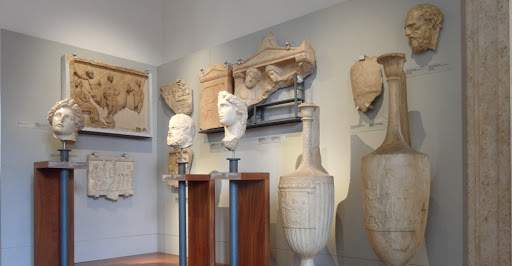Rome, 10 great Italian artists interpret Dante's Vita Nova at Museo Barracco
The Giovanni Barracco Museum of Ancient Sculpture in Rome presents the exhibition La Vita Nova: Love in Dante in the gaze of 10 female artists, conceived and curated by Alessandra Mammì and produced by Centro Studi Roccantica, an interdisciplinary cultural association founded by Ileana Florescu in 2018. After the first stop in Rome, until September 19, the project continues in Naples at the Madre Museum, a partner in the initiative.
The exhibition involves 10 contemporary Italian artists of different generations: Micol Assaël (Rome, 1979), photographer Letizia Battaglia(Palermo, 1935), Elisabetta Benassi (Rome, 1966), Marta dell’Angelo(Pavia, 1970), artist and film-maker Rä di Martino (Rome, 1975), Giosetta Fioroni (Rome, 1932), Marzia Migliora(Alessandria, 1972), Sabina Mirri (Rome, 1957), Elisa Montessori(Genoa, 1931) and a work of visual art by poet Patrizia Cavalli(Todi, 1947).
The project for this exhibition takes its cue from Dante Alighieri’s famous juvenile text, proposing to ask the artists for a work inspired by the themes of the Vita Nova: the celebration of love; the apparition and sanctification of the beloved woman; the union of love and death; spiritual elevation and the search for God through earthly love, but also the cruelty of love as it appears in Dante’s disturbing dream that imagines Beatrice in the act of eating his heart.
These are all themes that can be reworked through that visual research that, especially women artists since the second half of the twentieth century, have embraced from their own personal experience. One of the novelties of Dante’s text was precisely that it posed itself in an autobiographical form, in a kind of diary that investigates the feeling of love and distills it into a literary work with strong visual elements. The theme of this exhibition is not illustrative. Rather, it wants to offer a close comparison between the contemporary sensibility of a female artist and the eternity of a text that, beyond the many mystical, esoteric and allegorical interpretations, remains a paradigm of the discourse of love in the culture of the West.
Micol Assaël’s work is a reflection on time. Responding to Dante’s text, she constructs with traces, notes, fragments recovered from her travels and daily life, pages of a diary with an imperfect chronology. Photographer Letizia Battaglia translates the encounter between Dante and Beatrice into contemporary history, portraying Rosaria Schifani, (widow of Vito, Giovanni Falcone’s escort agent) and the Mediterranean sweetness of a child angel, along with the sculpture depicting Eleanor of Aragon. Elisabetta Benassi kicks off a collective performance that conceptually closes the circle of an exhibition that starts with a book and spreads in book form.
Poet Patrizia Cavalli, with a visual work plays from her own verses with the figure of the Muse, the etymology of the word, automatic writing and the dance between verse and color. Marta dell’Angelo proposes a painting that overcomes the body/mind dichotomy, placing the phenomenology of the body in contemporary culture at the center of the research.
Rä Di Martino compares photos of the lunar landscape provided by Nasa and silhouettes of a man and a woman cut out in gold leaf. Giosetta Fioroni’s works convey an immediate and eloquent language that interweaves emotions with popular forms and symbols from hearts to flowers and encodes a modern romanticism along with the vindication of feminist codes.
Marzia Migliora pays tribute to the Indian organization Navdanya, which proposes models of sustainable agriculture and promotes the improvement of women’s condition, suggesting that we shift our gaze from the angelic woman to the woman working in the fields.
In Sabina Mirri’s painting, the Supreme Poet is crowned, traced in the dry mark of medieval miniatures, with the many breasts of archaic deities. Painter Elisa Montessori pursues Beatrice in the Comedy to meet her thoughts and translate with inks and glazes, the verses in which the angelic creature in Paradise finally has a voice of her own.
The setting for this exciting and compelling exhibition, which showcases 10 different ways of making art in addressing the proposed themes, is the Giovanni Barracco Museum of Ancient Sculpture.
The venue, a building designed by Antonio da Sangallo, houses the collection of antiquities donated by Giovanni Barracco to the city of Rome in 1904. Today, the Barracco collection, consisting of timelessly beautiful artifacts-ranging from Egyptian to Sumerian and Assyrian art, from Hellenistic sculpture to Roman fresco painting-is intersected with the works of women artists, with the aim of creating an intimate and at once choral space.
For all information you can visit the museum’s official website.
 |
| Rome, 10 great Italian artists interpret Dante's Vita Nova at Museo Barracco |
Warning: the translation into English of the original Italian article was created using automatic tools. We undertake to review all articles, but we do not guarantee the total absence of inaccuracies in the translation due to the program. You can find the original by clicking on the ITA button. If you find any mistake,please contact us.




























